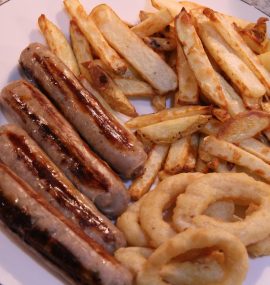Ultra-processed foods promote over-eating
Practical steps you can take to eat less ultra-processed food
Ultra-processed foods (UPFs) typically include industrial formulations of five or more ingredients, especially salt, sugar, fats, flavors, and colors. Common UPFs include candies, mass-produced breads, energy bars, sugar-sweetened drinks, frozen dinners, and most snack foods. People who eat lots of UPFs tend to have poor diets with high amounts of refined grains, sugar, salt, and minimal fiber. In should come as no surprise that cross-sectional, longitudinal, and randomized trial studies link eating lots of UPFs with chronic diseases, such as cancer, hypertension, and obesity.
The food industry has developed highly sophisticated, effective ways to entice us to buy and eat their irresistible products. What can you do to counter the intensive advertising of UPFs and these foods’ ability to cause you to overeat? Psychologists and consumer behavior scientists have identified several tactics.
Identify cues in your environment that lead you to eat processed foods. Avoid these cues as much as possible. If you’re tempted to stop by a fast-food joint on the way home from work, take a different route home. If you can’t take a different route, imagine the sign for the fast-food joint (or whatever the cue may be). Change the image’s color to black-and-white. Make the image blurry. Shrink the size of the image. Move the image far away and behind you where you can’t see it.
If attractive packaging of UPFs at the grocery store gets you salivating, avoid walking down aisles with attractively packaged processed foods that especially appeal to you. Avoid the aisles with soft drinks, crackers, candy, deserts, and microwaveable dinners. Leave highly processed foods at the grocery store.
Write a health-related goal that grabs you. Limiting your processed food consumption may help you move toward your goal. Identify behaviors that you want to perform or avoid in pursuit of your goal. Vividly imagine how good you’ll feel when you get off the junk food bandwagon. Think differently about ultra-processed foods. When you find yourself wanting to stop at the donut shop on your way to work, imagine the grease in the donut clogging your arteries. Imagine the donut feeling heavy in your stomach. Imaging your heart having to pump harder to get your blood to your brain. Imaging the junk food turning into belly fat and fat inside your liver and pancreas. Imaging what it would be like to develop type 2 diabetes.
Use mental contrasting and implementation intentions. Once you’ve written your goal, imagine having attained your desired outcome. Then identify potential roadblocks to achieving your goal. For example, if your goal is to live with lots of energy, think of how great you will feel and all that you will be able to do in your highly energized state. Then think of possible roadblocks, such as eating your daily humongous bowl of ice cream. Think of one or more practical steps you could take to eat less ice cream. For example, stop buying ice cream for one week. Now think of a situation that would tempt you to buy ice cream. An implementation intention takes the form of an “If [the cue that prompts you to want junk food], then [the behavior you want to avoid or perform) statement. Your implementation intention might be: If I go grocery shopping, then I will avoid the ice cream aisle. I used this implementation intention to drastically reduce my ice cream consumption.
Pay attention to what you eat, particularly to how you feel. Being distracted leads to mindless eating. Thus, avoid eating dinner while watching television. Avoid snacking while reading or while driving, because you will probably underestimate how much you eat.
Choose less sweet versions of foods you buy. I ate vanilla yogurt for years. It contained 26 grams of added sugar per serving. That’s the recommended daily limit from the American Heart Association for adult men. I slowly weaned myself from highly sweetened yogurt and now happily eat plain Greek yogurt with no added sugar.
Eat dinner on smaller plates and bowls. The area of the average American dinner plate increased by 36 percent between 1960 and 2006. Research by Brian Wansink showed that people ate more dinner when it was served on larger plates and in larger bowls and less on smaller plates and bowls. Eating from small serving dishes can create a new norm of eating less food. We tend to underestimate our calorie intake. To make matters worse, the disparity between perceived and actual caloric intake increases as portion size increases.
Changing your food environment may be most effective way to reduce excessive eating compared to eating mindfully. Buy food in smaller packages to help develop a new norm of less eating. Remove ultra-processed foods from attractive packages and place them in clear, zip-type plastic bags in a cupboard. Keep processed foods packages out of sight when not in use. Out of sight, out of mind.
Limit your consumption of sweet, liquid calories. Our bodies may not recognize the caloric value of what we drink. Think soft drinks, sports drinks, beer, wine, and fruit juice (either fake or real).
Shift your food intake away from eating out at restaurants, especially fast-food and chain operations, to preparing meals at home with identifiable ingredients such as fresh or frozen vegetables and fruits, plain yogurt, nuts, and beans.
Do want to see yourself as a helpless pawn of the food industry? If not, try one of the above suggestions that you think will work for you. Then try another. You can kick the ultra-processed food habit.




